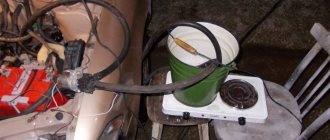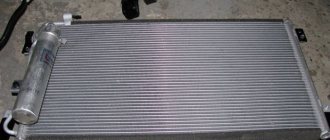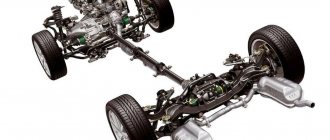Domestic car enthusiasts are often interested in the question of how to insulate a car radiator for the winter. This is a very pressing problem, because the cold season in most parts of our country is long. Moreover, in some regions a frost of -10°C is considered almost a thaw. Therefore, car owners often face various problems during this period of time.
In addition to difficulties starting the engine, fuel consumption increases. After all, the car must idle for some time. If this is not done, engine parts may be damaged.
Thickened lubricant cannot fully lubricate the rubbing elements. It takes some time to reach its normal temperature. To reduce the time required to reach operating temperature, radiator insulation is used.
Content
How to insulate a car radiator for the winter is a rather multifaceted question; there are several different ways to carry out this work. At the same time, there are several myths circulating among drivers about this modification of the cooling system. Despite the fact that they are not true, these myths are quite tenacious and popular:
- Reducing fuel consumption by 20% when using special protective equipment. This myth is inspired by the advertising efforts of manufacturers of such insulation. In practice, of course, fuel consumption is slightly reduced due to faster warm-up. But the savings are much lower. But such kits are very expensive;
- Insulating the radiator makes it easier to start the engine in the morning. If your car has been parked for only a couple of hours, the insulation will retain some of the heat, and the engine will start faster and easier. Having stood in the cold all night, the engine will cool down even with very good insulation. Therefore, insulating the radiator will not give you any advantage when starting up.
Now that you have become familiar with the mythology of insulating the radiator and engine compartment, you can begin the actual work of protecting this part of the car from the cold.
Is this necessary?
First you need to answer the main question. It consists of whether it is necessary to close the radiator of a car from the cold in winter and for what purposes various types of barriers, inserts and insulation are used.
Here it is important to clearly divide cars into new and old.
Let's start with old cars. Radiators have been closed for a long time. Various types of cardboard could be found several decades ago. Many people still install them out of habit.
To understand the essence of such manipulations, you need to remember about old radiators. In old cars, the radiator was cooled by a special fan, which was connected to the crankshaft and spun the blades. The higher the car speed, the faster the fan rotates. That is, at high speed the cooling was more intense.
The shortcomings of the system are quite obvious. The driver cannot in any way regulate the operation of the fan depending on the outside temperature. That is, even in winter the fan actively spun up and blew on the radiator. This did not allow the internal combustion engine to warm up to the required temperature; at speed it could cool down. In the summer, its shortcomings also manifested themselves when overheating occurred at idle.
From all that has been said, it is clear that in winter on old cars it was really important to limit the exposure of the radiator to cold oncoming air flows. For this purpose, cardboard boxes and their analogues were installed.
It’s also worth taking a look at the new cars. Modern cooling systems are significantly different. It is activated only when the engine temperature reaches the maximum temperature of 90-95 degrees Celsius. To control this process, a thermostat is used. The cooling system has become electronic; there is no longer any connection with the crankshaft. This allows the engine not to boil even in extreme heat in summer, and rarely turns on in winter. This is due to the fact that in winter the radiator has enough cold air coming from the environment through the radiator grille.
It will be useful: How to lower a car correctly?
Despite such an advanced and smart cooling system, new cars are still equipped with partitions, cardboards and similar products that prevent oncoming air flows from reaching the radiator.
This decision is not without meaning. Installing a barrier allows you to retain more heat under the hood and in the engine. This makes starting easier during severe frosts. At the same time, fuel consumption drops slightly, and the interior warms up faster due to the active heating of the heater radiator.
But you shouldn’t believe those who claim that installing a partition allows you to save about 25% of fuel in winter. This is just a marketing ploy. In fact, there are savings, but they are much smaller. This is due to the fact that when insulated, the engine warms up faster in winter, and therefore spends less fuel on it.
As for the simplified launch, everything is conditional. If the car is left in the cold for literally 2-3 hours, due to insulation you can actually retain some of the heat, after which the engine can start more easily. But if it’s cold outside and the car has been parked all night, the insulation will not be able to retain heat for such a time.
As you can see, there is a point in using partitions. Although some expectations are too high and do not correspond to reality.
Ready-made kits
In auto parts stores you can find various kits for insulating the engine and radiator for the winter. The advantage of such an acquisition is that there is no need to independently select materials and adjust them. But this approach also has disadvantages. First of all, the cost is quite high. At the same time, they sell you simply cut insulation, packed in a bag. Exactly the same material can be purchased at any hardware store.
Another drawback is low frost protection. The materials used for such kits are far from being of the highest quality. Therefore, even at -12°C, insulating elements cannot cope. In this regard, many people strive to insulate the engine compartment with their own hands.
Insulation yourself
The easiest option is to insert pieces of cardboard between the grille and the radiator. This allows you to slightly reduce heat loss when traveling in winter. But this is not very effective. Besides, it's not very aesthetically pleasing. Therefore, it is best to use more modern insulation methods. Please note that working with radiator insulation is not enough.
You should also pay attention to the entire engine and engine compartment. When installing, be sure to securely fasten the insulation correctly. If it accidentally gets under the generator or timing belts, you will have to make expensive repairs to these systems.
How to insulate?
The radiator is insulated in 2 ways. They differ in complexity of execution:
- The easiest option is to take a piece of thermal insulation and insert it in front of the radiator. This allows you to remove and install insulation if necessary without wasting extra time;
- Other drivers place insulation in front of the false radiator grille. For this purpose, a cover is sewn from leatherette. Insulation is placed in it. And all this is attached to the grille. The case should have valves that allow air access to the radiator as the temperature rises.
But insulating the radiator is not enough. You also need to pay attention to the engine. The easiest way is to cover the inside of the hood and engine compartment with insulating material. This will significantly reduce heat loss. Another method of insulation is to make a so-called car blanket (see the article “Which car blanket is best to choose”). For this, heat-resistant material is purchased. It is cut to the size of the engine compartment. After which the resulting “blanket” is covered with the engine. In regions with severe frosts, it would be a good idea to cover the crankcase and sides of the engine with insulation.
Conclusion
. Winter is quite a difficult time for every car enthusiast. Other inconveniences include low temperatures. Interfering with the engine's ability to operate normally. Therefore, many people wonder how to insulate a car radiator for the winter. At the same time, the insulation work is not difficult. The main thing is to do everything carefully.
Starting the engine in winter is half the battle. To warm up. The standard oven can help, but warm up the engine first. Quickly? Then the coolant preheater will help. It will also help maintain the efficiency of the heater while on the go. Expensive? Look for ways to retain heat in the cooling system. One of the techniques is based on covering the radiator grille. The experimental base is large and there are many controversies.
Tags: radiator grille insulation, lifan x60
Comments 151
It is not clear how exactly it is attached to the radiator?
We attach the elastic loops through them to the grille in the form of hooks)) (I used paper clips in plastic)
From my experience in operating a VAZ 21043, it makes sense to cover only the lower 2/3 of the radiator.
All criticism comes from those who experience -30 times a year. And if you drive every day in cold weather, then you won’t be able to do without insulation. It’s all the rage here - isolon on adhesive tape in a circle and strips of the same adhesive tape imitating a radiator grille. I'll make a selection and post it.
You sold your Lada early. . .
Everyone is so angry, it’s immediately obvious that they have never driven a Lada))
In fact, the cars are so individual that one needs to be insulated, the other does not. Apparently such haters are just lucky, or don’t care about the temperature of the engine and the cabin)
And our temperature is above zero...
We will have it soon too)) months h/w 3 - 3.5)
Very confused, a lot of free time. =))
holidays 10 days)
Cool! Does the template (cardboard) have to have a cut?











